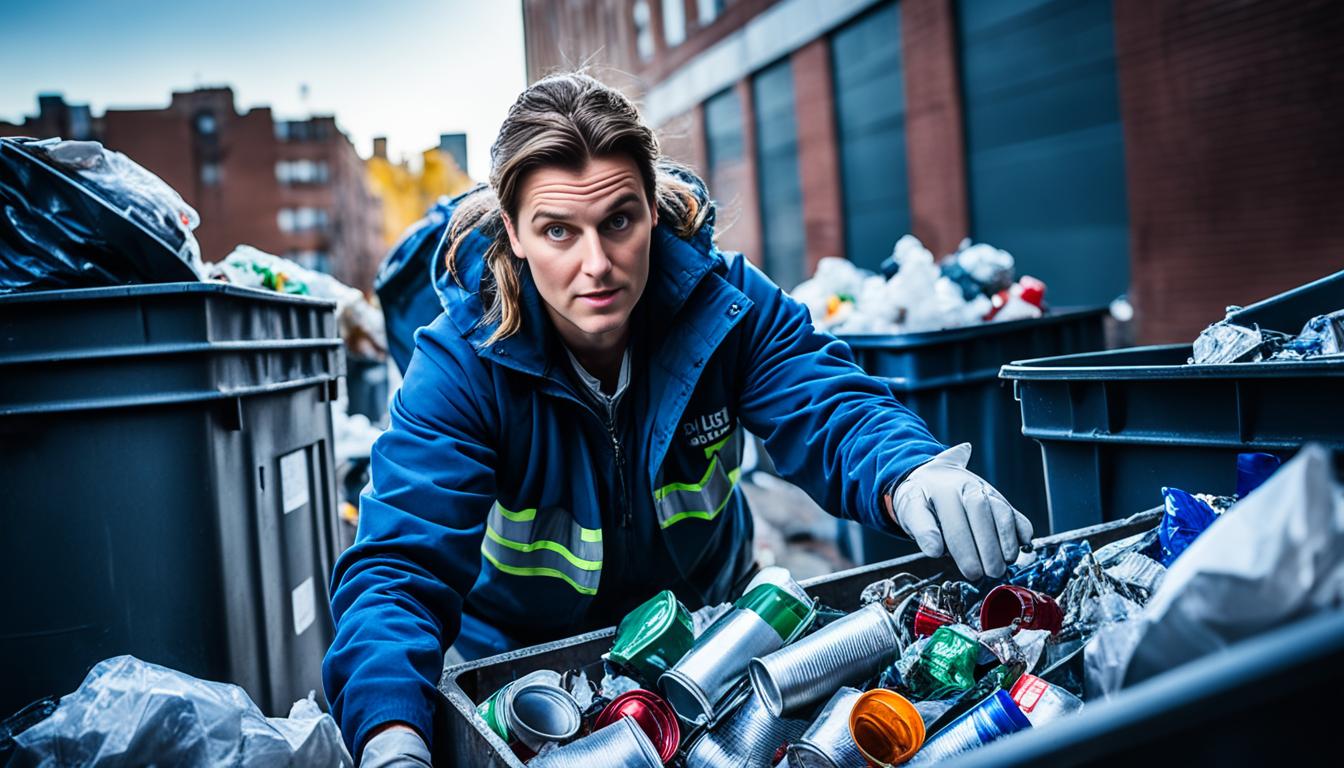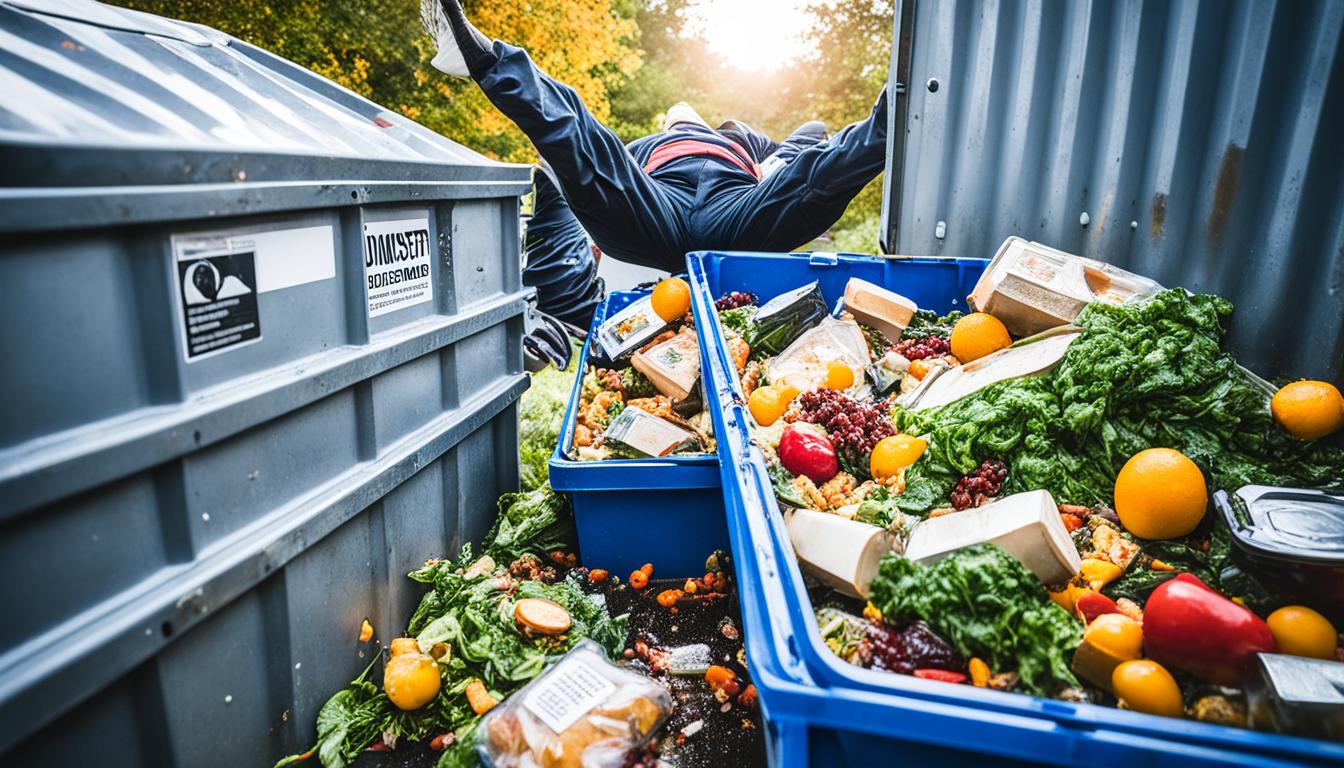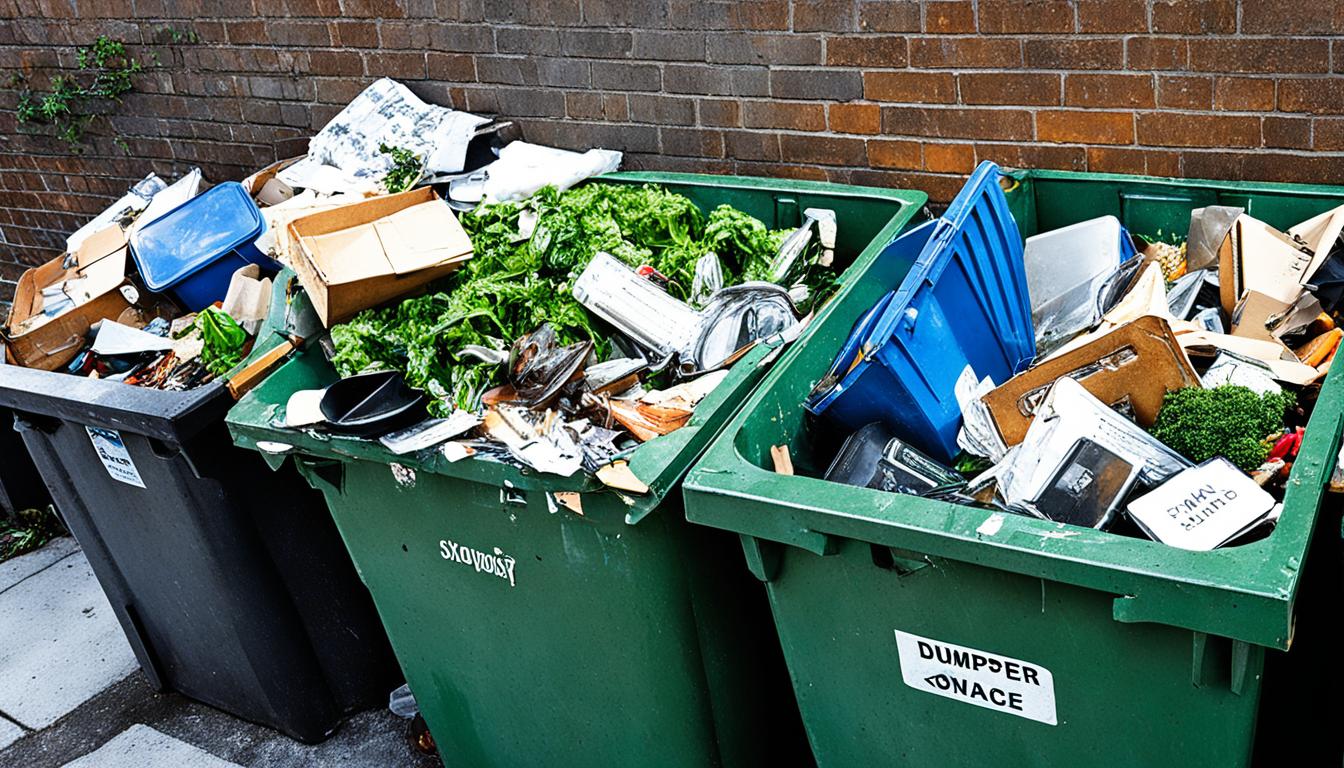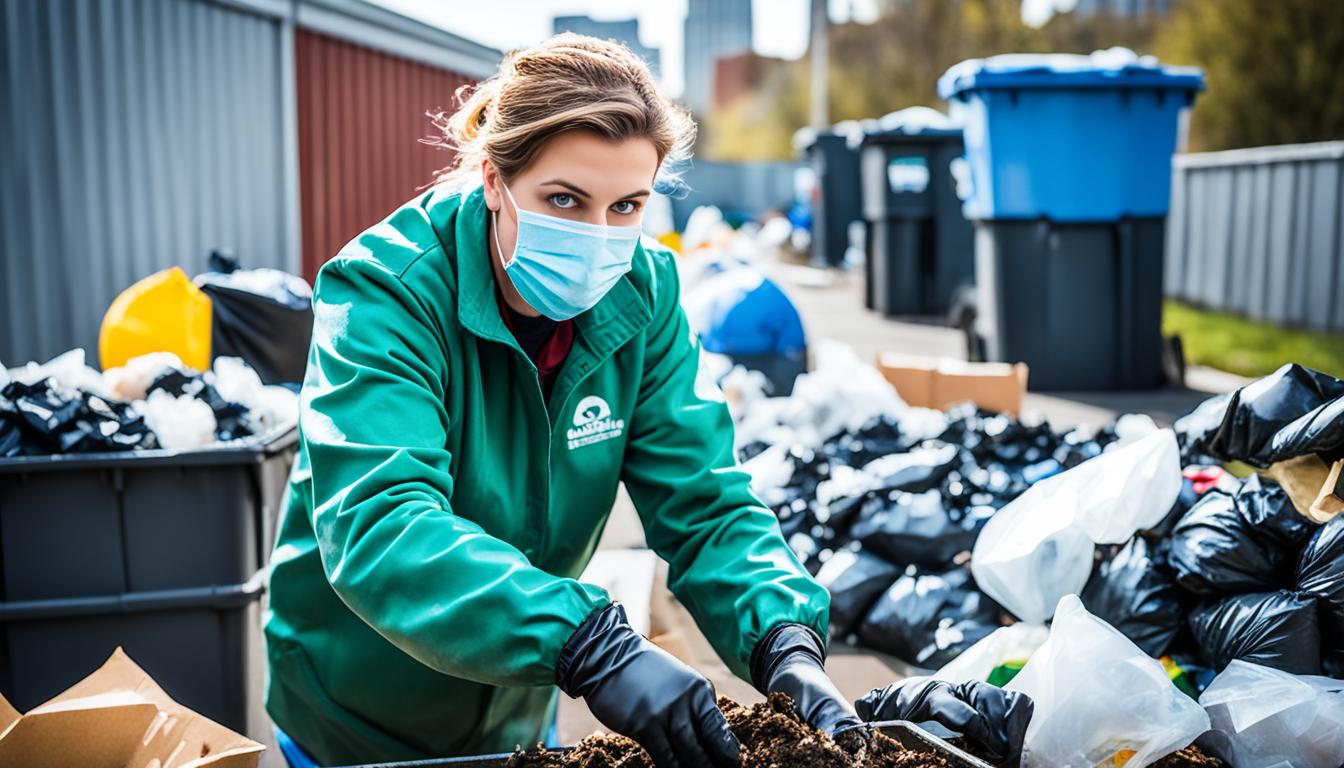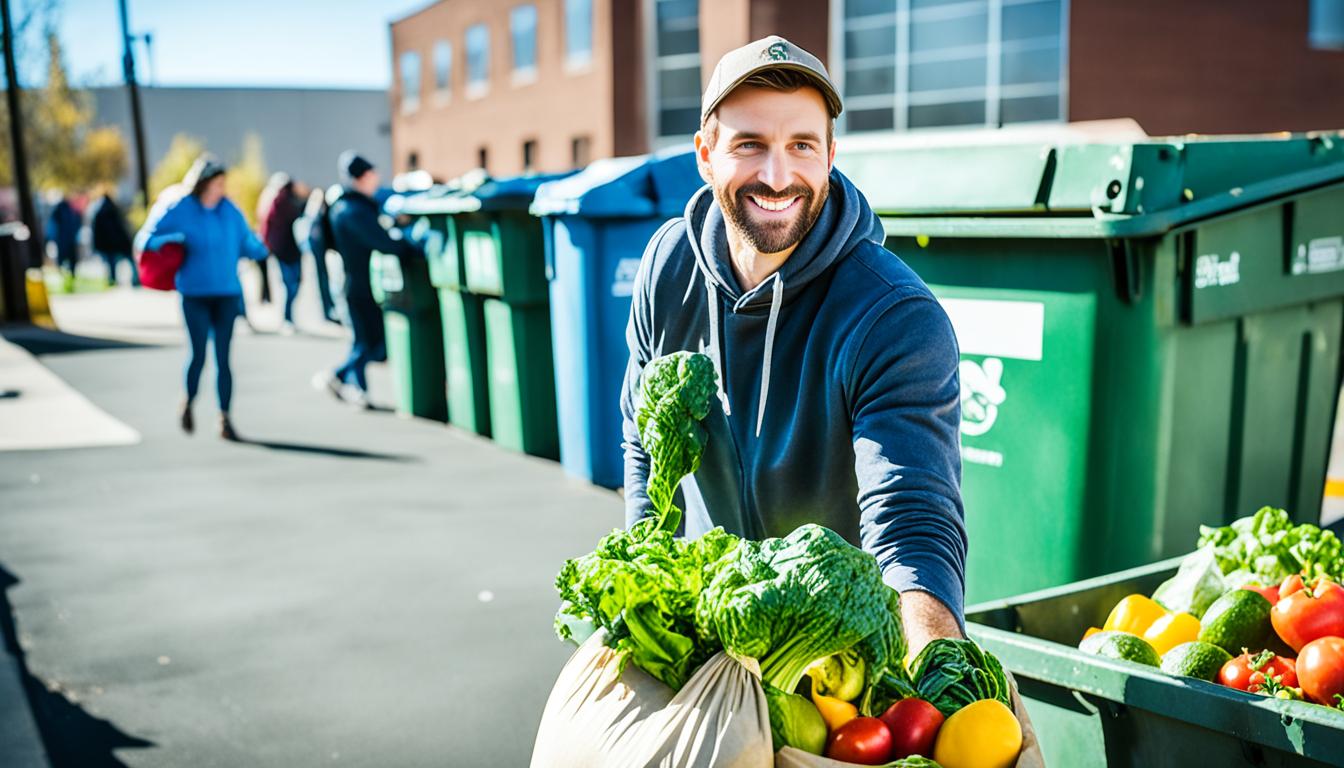Disclosure: This Post Contains Affiliate Links; We earn a commission on purchases.
Dumpster diving can be a highly effective strategy for reducing waste and promoting environmental sustainability. It involves salvaging items from dumpsters, preventing them from ending up in landfills. Not only does this practice help raise awareness about food waste, but it also provides an individual solution to reduce our environmental impact. In this article, we will share some valuable tips for successful dumpster diving.
Key Takeaways:
- Dumpster diving is a strategy that can significantly reduce waste and promote environmental sustainability.
- By salvaging items from dumpsters, individuals can prevent reusable resources from ending up in landfills.
- Successful dumpster diving requires planning, preparation, and caution.
- It is important to be aware of legal and hygiene considerations while engaging in dumpster diving.
- Dumpster diving aligns with the principles of a circular economy and resource efficiency.
Top 10 Tips for Dumpster Diving Success
Dumpster diving is not only an excellent way to reduce waste and combat food waste but also an opportunity to make a positive impact on the environment. By salvaging perfectly good items from dumpsters, we can minimize our environmental footprint and promote sustainability. To help you make the most of your dumpster diving adventures, here are 10 valuable tips:
- Play the numbers game: Increase your chances of success by visiting multiple dumpsters and moving quickly between locations. Planning your route in advance can help you stay organized.
- Go to the source: Dive at places that sell the type of food or items you want to find. Grocery stores, pharmacies, and farmers markets are good places to start.
- Get in and look around: Don’t be discouraged if you don’t see anything from outside the dumpster. Often, there are bags or boxes of perfectly good food just below the surface.
- Manage your fear: Stay calm and confident while dumpster diving. It’s rare to encounter legal issues, and the potential benefits outweigh the risks.
- Be prepared: Bring necessary supplies such as containers, gloves, headlamp, and soap/water for hygiene. Dress appropriately and clean out your car beforehand.
- Focus on middle and upper income areas: These neighborhoods tend to have more accessible dumpsters with higher chances of finding valuable items.
- Go with a friend if possible: Having a partner can make the process easier and more enjoyable. One person can collect items while the other transports them.
- Don’t let locks fool you: Check if the dumpster is actually locked before assuming it is. Some locked dumpsters can still be accessed with a little creativity.
- Look for compost bins and other dumpsters: Explore the surrounding areas to find additional dumpsters that may contain food or other useful items.
- Create a route and schedule: Over time, you’ll learn which locations are worth your time. Develop an efficient route to maximize your success.
By following these tips, you’ll be well on your way to successful and rewarding dumpster diving experiences. Remember to always prioritize safety, legality, and respectful behavior during your dives. Happy dumpster diving!
| Benefit | Tip |
|---|---|
| Increased chances of finding valuable items | Play the numbers game: visit multiple dumpsters and move quickly between locations |
| Efficient diving | Go to places that sell the items you want to find |
| Discover hidden treasures | Don’t be discouraged if you don’t see anything from outside the dumpster |
| Promote confidence and peace of mind | Stay calm and confident while dumpster diving |
| Well-prepared for the dive | Bring necessary supplies and dress appropriately |
| Find valuable items | Focus on dumpsters in middle and upper-income areas |
| Enhanced diving experience | Go with a friend if possible |
| Unlock hidden treasures | Double-check if a locked dumpster is actually inaccessible |
| Expand your options | Look for compost bins and other dumpsters in the vicinity |
| Optimized diving routine | Create an efficient route and schedule your diving trips |
Preventing Dumpster Diving on Your Property
Businesses and property owners may have concerns about dumpster diving on their premises due to liability and privacy issues. It is important to take measures to prevent unauthorized access to waste receptacles and maintain the overall security of your property. By implementing effective strategies, you can mitigate liability concerns and protect your business or property. Here are some tips to prevent dumpster diving and enhance dumpster security:
- Secure and Lock Dumpsters: Use secure and lockable dumpsters to prevent unauthorized access. Make sure the lids are properly closed and locked at all times.
- Install Surveillance Cameras: Install surveillance cameras in areas near dumpsters to deter potential dumpster divers. Make sure the cameras are visible to act as a deterrent.
- Proper Lighting: Ensure adequate lighting around dumpsters to minimize the risk of nighttime dumpster diving. Well-lit areas discourage unauthorized access.
- Signage: Display clear and visible signs indicating that dumpster diving is prohibited. This helps to establish liability and discourage potential divers.
- Regular Monitoring: Assign responsible personnel to regularly inspect and monitor the dumpsters for any unusual activities. Promptly report any suspicious individuals or incidents to the authorities.
- Encourage Community Watch: Collaborate with neighboring businesses or property owners to establish a community watch program. By collectively addressing dumpster diving concerns, you can enhance security in the area.
- Utilize Dumpster Enclosures: Consider installing dumpster enclosures to physically restrict access and prevent unauthorized individuals from easily accessing the dumpsters.
In addition to preventing dumpster diving, proper waste management practices are essential for maintaining a clean and organized property. Regularly schedule waste pickups and ensure that trash receptacles are emptied and maintained in a timely manner. By prioritizing waste management and dumpster security, you can minimize liability concerns and protect your property from unwanted access.
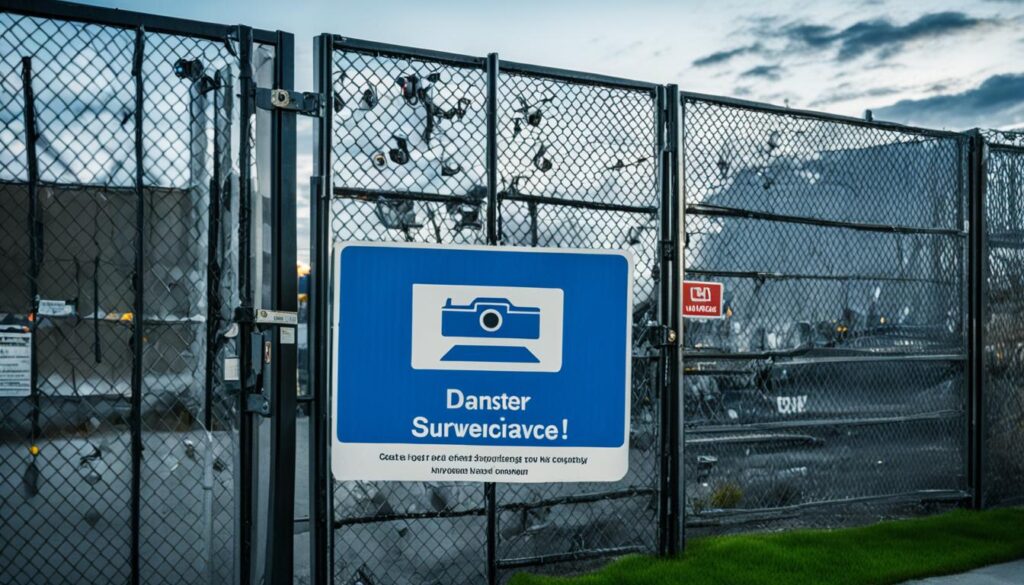
Locating and Evaluating Dumpsters for Success
Finding suitable dumpsters for diving requires scouting different locations. Here are some tips for success:
1. Explore Urban Neighborhoods
Urban neighborhoods often have a higher concentration of businesses and public locations, making them ideal for dumpster diving. Grocery stores, restaurants, and shopping centers are likely to have dumpsters that may contain valuable items.
2. Research Dumpster Locations
Prioritize areas where dumpsters are easily accessible and legally accessible. Local regulations may prohibit diving in certain places, so it’s crucial to know the laws regarding dumpster diving in your area.
3. Scout Public Locations
Public locations such as parks, universities, and office complexes may have dumpsters that are less frequently monitored. These areas can be fruitful for finding discarded items.
4. Look for Clues
Keep an eye out for signs of dumpster activity, such as broken locks or bags of trash placed outside the dumpster. These indicators suggest that the dumpster may have valuable items.
5. Assess Waste Items
Before diving into a dumpster, evaluate the types of waste items visible from the outside. Look for signs of discarded food, household goods, or electronics, as these can be valuable finds.
To give you an idea of what to expect, take a look at this image showcasing a dumpster filled with various waste items:
By diligently scouting dumpsters in urban neighborhoods and public locations, you can increase your chances of finding valuable items and reducing unnecessary waste.
Tips for a Successful Dumpster Dive
When engaging in dumpster diving, it is important to prioritize safety and take the necessary precautions to ensure a successful and safe experience. Here are some tips to keep in mind:
- Wear appropriate attire: Dress in comfortable clothing that allows for easy movement and protection from potential hazards. Long pants, closed-toe shoes, and gloves are recommended to protect against sharp objects or unsanitary conditions.
- Use protective gear: Consider wearing a headlamp or flashlight to improve visibility, especially if diving at night. Additionally, wearing a face mask or goggles can help protect against dust, debris, or unpleasant odors.
- Inspect the dumpster: Before diving in, take a moment to carefully assess the dumpster for any visible dangers such as broken glass, sharp objects, or pests. Avoid diving into dumpsters that appear unstable or unsafe.
- Stay cautious and alert: Always be aware of your surroundings and exercise caution while diving. Watch out for uneven surfaces, slippery spots, or unstable piles of items within the dumpster.
- Bring necessary tools: A sturdy stick or grabbing tool can be handy for reaching items that are out of reach or buried under other objects. However, avoid using tools that may damage the dumpster or cause potential hazards.
Remember, safety should be your top priority while dumpster diving. By taking the appropriate safety precautions and wearing protective gear, you can minimize the risks and enjoy a successful dive.
Keep in mind that each location and situation may present unique challenges and hazards. Use your judgment and adapt these tips accordingly to ensure your own safety during each dumpster dive.
Recommended Safety Precautions for Dumpster Diving
| Safety Precautions | Description |
|---|---|
| Wear Appropriate Attire | Dress in comfortable clothing that provides protection against potential hazards. |
| Use Protective Gear | Wear a headlamp, gloves, face mask, or goggles to enhance safety and minimize risks. |
| Inspect the Dumpster | Carefully assess the dumpster for any visible dangers before diving in. |
| Stay Cautious and Alert | Be aware of your surroundings and watch out for potential hazards. |
| Bring Necessary Tools | Carry a sturdy stick or grabbing tool to safely reach items. |
Making the Most of Your Dumpster Diving Haul
When salvaging items from dumpsters, it’s crucial to consider the responsible use of finds, waste prevention, and reducing unnecessary accumulation. Here are some tips to help you make the most out of your dumpster diving haul:
1. Prioritize Useful and Functional Items
While it may be tempting to salvage everything you come across, it’s important to focus on finding items that serve a purpose in your life. This approach encourages responsible use of rescued items and prevents unnecessary accumulation of objects that may go unused or end up being discarded again.
2. Repair and Repurpose
Instead of immediately discarding items that appear broken or damaged, consider repairing or repurposing them. With a little creativity, you can give salvaged items a new lease on life, reducing the amount of waste generated and extending the lifespan of the products.
3. Share with Others
If you find items that you don’t need but are still in good condition, consider sharing them with friends, family, or local organizations. Donating or giving away salvaged items ensures they continue to be used and prevents them from going to waste.
“By prioritizing responsible use and sharing our finds, we can contribute to waste prevention and a more sustainable future.” – [Your Name]
4. Take Safety Precautions
When handling salvaged items, it’s essential to prioritize your safety. Wear appropriate protective gear, such as gloves, when necessary. Clean and sanitize items thoroughly before using them to ensure they are safe for use.
5. Avoid Hoarding
While dumpster diving can be exciting and fruitful, it’s important to resist the urge to accumulate more than you need. Practice mindful consumption and only salvage items that you have a genuine use for. This approach helps prevent unnecessary accumulation and reduces waste in the long run.
Implementing these tips promotes responsible and sustainable practices when utilizing salvaged items from dumpsters. By adopting a mindful approach to waste prevention and reducing unnecessary accumulation, we can contribute to a greener and more eco-friendly lifestyle.
Dumpster Diving Safety and Hygiene
Dumpster diving can be an exciting and rewarding activity, but it’s important to be aware of the potential health risks involved. By practicing cautious diving and maintaining good hygiene, you can enjoy your dumpster diving adventures while minimizing hazards. Here are some tips to keep in mind:
- Wear protective gear: When diving into dumpsters, it’s crucial to protect yourself. Wear sturdy gloves to avoid cuts or punctures and consider wearing closed-toe shoes for added safety.
- Avoid hazardous materials: While dumpster diving, be cautious of dumpsters that may contain hazardous waste, such as chemicals or sharp objects. If you come across any suspicious or dangerous items, it’s best to leave them untouched.
- Maintain good hygiene: Dumpster diving can be a dirty business, so it’s essential to maintain good hygiene. After each dive, thoroughly wash your hands with soap and water or use hand sanitizer to minimize the risk of contamination.
- Inspect items before use: Before using or consuming any salvaged items, thoroughly inspect them for signs of spoilage, damage, or contamination. It’s better to err on the side of caution and discard anything that appears unsafe or expired.
- Minimize contact with debris: As you dive into dumpsters, be mindful of the surrounding debris and waste. Try to minimize direct contact with trash by using tools like grabbers or tongs to handle items.
Remember, dumpster diving comes with inherent risks. It’s important to exercise caution, prioritize safety, and use common sense. By following these tips, you can mitigate potential health hazards and maintain a safe diving experience.
In addition to these precautions, it’s a good idea to stay up to date on local health and safety regulations to ensure compliance and minimize any potential legal risks. Happy and safe diving!
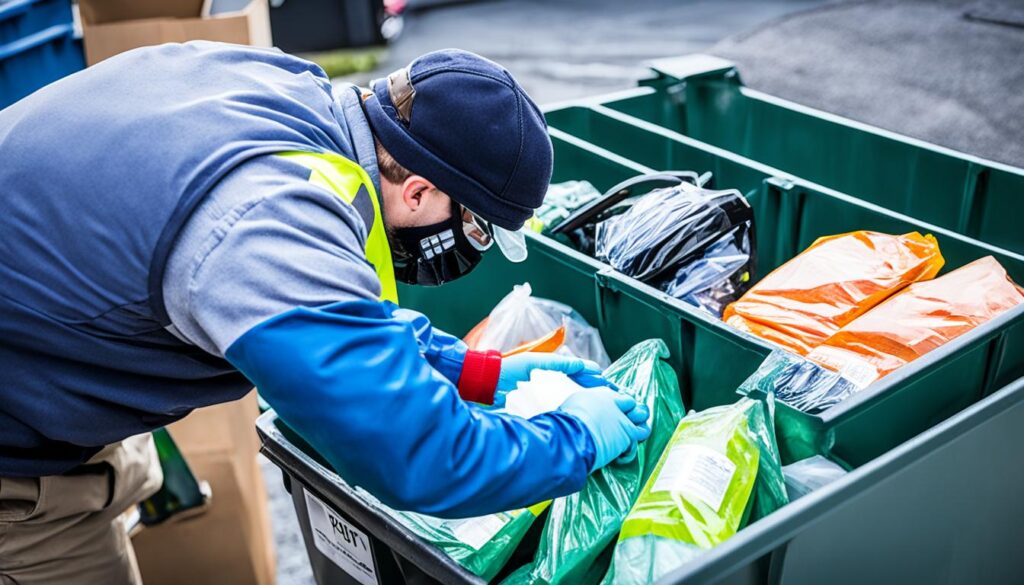
| Health Risk | Description |
|---|---|
| Contamination | There is a possibility of coming into contact with bacteria, viruses, or other pathogens present in the trash. |
| Sharp Objects | Dumpsters may contain sharp items or broken glass that can cause injuries if not handled carefully. |
| Chemical Exposure | Some dumpsters may contain discarded chemicals or cleaning products that can pose health hazards if mishandled or accidentally ingested. |
| Allergic Reactions | Individuals with allergies or sensitivities may encounter allergens or irritants within dumpsters, triggering allergic reactions. |
| Foodborne Illness | Improperly stored or spoiled food items can carry pathogens that may cause food poisoning or other foodborne illnesses. |
The Benefits of Waste Reduction Strategies
Implementing waste reduction strategies, such as dumpster diving, can have significant advantages for both individuals and the environment. By rescuing items from dumpsters, we can actively contribute to environmental conservation and combat the waste crisis that plagues our planet. Through this practice, we divert waste from landfills, reducing the associated environmental impact.
Dumpster diving also promotes resource efficiency by giving discarded items a second life. By repurposing and reusing these items, we can reduce the demand for new products and conserve valuable resources. This aligns with sustainable practices that aim to minimize the exploitation of natural resources and support the concept of a circular economy.
Furthermore, dumpster diving encourages sustainable living by fostering a mindset of responsible consumption. It encourages us to question our reliance on excessive consumerism and promotes a shift towards a more conscious and mindful lifestyle. By understanding the value of what we salvaged from the dumpsters, we can reduce unnecessary accumulation and contribute to waste prevention.
Source Links
- https://www.robingreenfield.org/dumpsterdivingtips/
- https://www.wikihow.com/Dumpster-Dive
- https://tri-statedisposal.com/7-tips-for-preventing-dumpster-diving-on-your-commercial-property/

Subscribe to Our Newsletter

